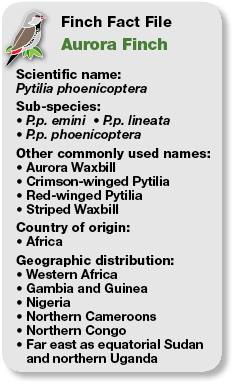Melba Finch. Photo: Ian White
Article kindly provided by Glenn Johnson
The family of finches called Pytilia are a colourful and popular group of finches that are always in demand by Australian and overseas aviculturists alike.
In Australia, the Melba Finch Pytilia melba and the Aurora Finch Pytilia phoenicoptera are extremely popular and have been kept with good breeding results, for decades. In recent years, there has been increased interest in the Red-faced Pytilia Pytilia hypogrammica and its very close look-alike, the Yellow-winged Red-faced Pytilia, which is a colour variation with the same scientific name. It is not a subspecies.
Melba Finch, Aurora Finch & Red-faced Pytilia Fact Files
Melba Finch
The Melba Finch (Pytilia melba) is considered the most colourful of this group and as such is the most popular. This particular species always catches the eye of beginners and experienced breeders alike. In recent years there has been a very high demand for these finches. However, as the numbers available to meet this demand are low, there has been a fairly sharp increase in this bird’s retail price.
Of the Pytilia family, the Melba Finch is the most heavily reliant on livefood. They will abandon chicks if a good supply of livefood is not continuously supplied. This reliance on livefood has seen a geographical trend, as to where this bird is more popularly kept. In the past, larger inner city areas have not been recognised as a stronghold for this bird. This species was bred in areas with large population of termites. In New South Wales the species has been bred in numbers in the Hunter Valley and the Southern Highlands, where there are plenty of termites. In recent years, breeders from non-traditional areas are having success by offering the birds bush fly maggots instead of termites.
Melba Finch. Photo: Ian White
As an aviary species, the Melba Finch can be aggressive in mixed collections. One of my hens killed three cocks in succession until I caught her in the act. This species can be overzealous when protecting their nests.
These birds require an enclosed aviary where they can seek shelter from bad weather. Long periods of wet weather are not good for this species and they will succumb if adequate shelter is not provided.
Aurora Finch
Due to their less colourful plumage the Aurora Finch (Pytilia phoenicoptera) is not as popular as the Melba Finch. However, in my experience, this species is easier to breed and keep than the Melba Finch and is not as aggressive or as intimidating. Their reliance on livefood is high but not as high as that of the Melba Finch. They tend not to be as tight sitters as Melba Finches so nest inspections or disturbance should be avoided. As these birds like thick, well-protected nest sites, plenty of tea-tree branches lining the aviary shelter is a definite asset.
Aurora Finch. Photo: Yoann Lombard. (https://www.flickr.com/photos/yoannlombard/)
Red-faced Pytilia
The Red-faced Pytilia (Pytilia hypogrammica) is a beautiful species that has gained popularity in recent years. It is very similar in nature to the Aurora Finch, although the plumage is more colourful. As the cock becomes older, the colourful plumage intensifies. The hen is slightly darker in colour than the Aurora Finch hen.
Some unscrupulous breeders may attempt to pass off an Aurora Finch hen for a Red-faced Pytilia hen, so be aware of this and buy only from reputable breeders. The husbandry of this species is identical to that of the Aurora Finch.
I have had no experience in keeping the Yellow-winged Pytilia, a colour variation of the Red-faced Pytilia, which is difficult to obtain and is kept by a few breeders, predominantly in Victoria and Tasmania. The Red-faced Pytilia is the dominant species, so let us hope that the dedicated few who are lucky enough to own the Yellow-winged Pytilia will have much success in keeping them.
“In Australia, the Melba Finch and the Aurora Finch are extremely popular and have been kept with good breeding results, for decades.”
Feeding
The Pytilia species discussed have similar housing and feeding requirements. I feed a basic commercial finch mix during the non-breeding season. As the breeding season commences I add niger seed, maw, linseed and black and white lettuce seed. I also introduce a dry egg and biscuit mix along with plan Madeira cake. The birds show more interest in grit, when they start nesting. During this period I substitute the basic small plain grit for a mix containing charcoal, canundra shell and baked crushed fowl eggshells.
During the breeding season, livefood is increased and is essential. Termites are excellent and have been the most widely used. As termites are becoming harder to obtain, I now supply bush fly maggots with great success. All my birds take these without hesitation. To provide dietary variety I also feed mealworms. Some breeders have had success using fruit fly and crickets.
Greenfoods in the form of summer grass, winter grass, chickweed and seeding millets are also consumed. These species are not as reliant on greenfood as our native finch species, however they will consume a reasonable amount.
Melba Finch. Photo copyright: Lyn Francey (https://www.flickr.com/photos/lynfrancey/)
Melba Finch. Photo copyright: Lyn Francey (https://www.flickr.com/photos/lynfrancey/)
Melba Finch. Photo copyright: Lyn Francey (https://www.flickr.com/photos/lynfrancey/)
Nesting
These species will breed in very dense cover and show no preference for live shrubs over tea-tree branches. My birds have bred in both nest boxes, tins and gourds and sometimes build their own nests. Nests are lined with feathers, coconut fibre and finer grasses such as November grass.
Nest disturbances or inspections must not be undertaken as the finches will toss young out easily. Once they breed they can produce nests in quick succession. It is wise to house only compatible pairs in the breeding aviary, and previous young should be removed, as unmated adults or previous young are inquisitive and can cause disturbances to nesting pairs.
The clutch size is usually 4-6 eggs with a reasonably high fertility rate of 70-75%. Incubation lasts for approximately 13 days with fledglings leaving the nest three weeks later.
As with many species, chicks will often leave the nest early and are difficult to return to the nest. In warm weather I place a good quantity of soft grass on the shelter floor, which in my set-up is separate from the flights and the chicks snuggle up in this for a few days until they fly. In cold weather I put them in a carry box overnight and return them to the aviary the next morning.
Conclusions
Regular husbandry practices are necessary to treat for worms, coccidiosis and mites.
If these birds are provided with good quality food and well-sheltered aviaries they will thrive and produce many healthy chicks. They are a long-lived and hardy species that deserve a place in your aviary.
Melba Finch. Photo: Ian White






